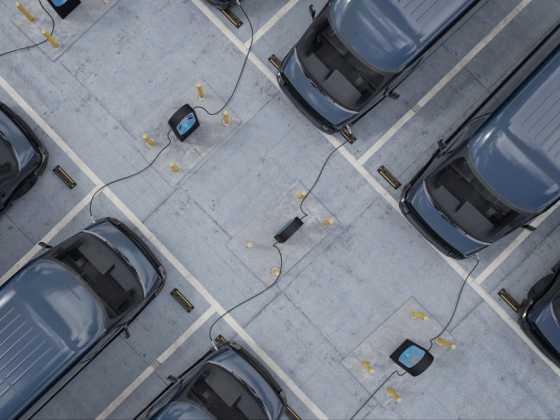Accelerating action against climate change

With eyes on the UK for hosting the 26th UN Climate Change Conference of the Parties (COP26) in Glasgow this November, we look at what the UK government is doing to accelerate the switch to zero emission transport
The UK will host the 26th UN Climate Change Conference of the Parties (COP26) in Glasgow on 31 October to 12 November 2021.
The COP26 summit will bring parties together to accelerate action towards the goals of the Paris Agreement and the UN Framework Convention on Climate Change.
The Paris Agreement is a legally binding international treaty on climate change. Its goal is to limit global warming to well below 2, preferably to 1.5 degrees Celsius, compared to pre-industrial levels.
One significant way to do this is to remove the harmful emissions caused by transport.
A shift to zero emission vehicles is already underway, but to meet climate targets, this transition needs to happen much more quickly and cover not only cars, but vans, buses, trucks, and lorries.
As the host nation for COP26, the UK is using this platform to publicise its plans to get to net zero by 2050, and is urging others to do the same.
Getting to net zero
The UK government has already announced that from 2030, only cars with a substantial zero emission range will be available to buy, mainly battery electric vehicles and some plug-in hybrid electric vehicles. From 2035, all new cars and vans must be fully zero emission at the tailpipe, meaning battery electric vehicles only, and possibly hydrogen fuel cell vehicles.
In recent days, the government has published its Net Zero Strategy, setting out the support being made available to transition to clean energy and green technology.
As part of the strategy, another £620 million was announced for targeted electric vehicle grants and infrastructure, with a focus on local on-street residential charge points.
A further £350 million of the Automotive Transformation Fund (ATF) has also been released, to support the electrification of UK vehicles and their supply chains. There’s also a commitment for £140 million support for hydrogen.
Another key policy within the strategy is a zero emission vehicle mandate. This will help to speed the transition to zero emission vehicles by forcing car firms to make EVs account for an increasingly large part of their fleet.
Transport Secretary Grant Shapps said: “We’re going further and faster than ever to tackle climate change. Together with an additional £620 million to support vehicle grants and charging infrastructure, our plans for an ambitious zero emission vehicle mandate show that we’re leading the world on the switch to EVs.
“We published our Transport Decarbonisation Plan in July which was just the start – as we look ahead to the COP26 climate change conference and beyond, we need to continue our efforts to deliver its ambitious commitments. This will provide certainty to drivers and industry as we create sustainable economic growth, boost job opportunities and clean up the air in our towns and cities.”
Transport decarbonisation
Earlier in the year, the government published its transport decarbonisation plan, setting out a pathway for the whole transport sector to reach net zero by 2050. It covers more details about how the HGV market can become zero emission, given that electrification is more challenging for heavy goods vehicles.
As pledged in the plan, the government has now consulted on proposals to phase out the sale of new diesel and petrol heavy goods vehicles. The consultation proposed a 2035 phase out date for vehicles weighing from 3.5 to 26 tonnes, and 2040 for vehicles weighing more than 26 tonnes. The consultation is now complete and the feedback is being analysed.
The government is also gathering feedback on whether to increase maximum vehicle weights for alternatively fuelled and zero emission trucks. This would offset the additional weight from the use of batteries and/or hydrogen storage tanks, increasing their commercial viability and attractiveness to operators.
Given uncertainty about which zero emission technology is most suitable for decarbonising long-haul HGVs, the strategy says it will demonstrate zero emission truck technology on the roads this year. As such, the government says it will invest £20 million this year to support industry to develop cost-effective, zero emission HGVs and refuelling infrastructure. This includes designing electric road system and hydrogen fuel cell trials, developing technology and UK supply chains, and providing funding to demonstrate and prove real world applications of emerging battery electric trucks.
The government also plans to stimulate demand for zero emission trucks through financial and non-financial incentives, acknowledging that that any zero emission vehicles on the market have a higher upfront price than diesel equivalents.
Regarding the UK’s existing HGV fleet, the strategy commits to supporting efficiency improvements and emission reductions. Ways to do this include using the Energy Saving Trust’s online Freight Portal, which showcases the commercial benefits of improved fuel and logistical efficiencies, including information on available technologies, training and advice which operators can adopt to save time and money while reducing their emissions.
Support will continue for organisations like Zemo Partnership and others in identifying zero emission solutions for transport refrigeration units and auxiliary power units, producing an action plan for identifying the technologies available, barriers to introduction, and opportunities.
There will also be work done to explore the potential to increase the biocontent in fuels for use in compatible vehicles, for example through the use of higher blends of biofuels or drop-in fuels.
The government has also committed to maintaining the fuel duty differential up to 2032, subject to review in 2024, to encourage the use of biomethane and other gaseous fuels that create carbon savings compared to fossil fuels.
Sustainable freight
The plan highlights that encouraging a shift from road to more sustainable alternatives, such as rail, cargo bike and inland waterways, can decarbonise freight. To do this, the strategy says it will be investing in the capacity and capability of the rail network for freight.
‘Last mile’ deliveries will also be looked at, as this has the potential to create healthier and more liveable places. The government says it will work with industry, academia, and other stakeholders to understand how innovation in the Category L sector can benefit the UK delivery market.
It is also reviewing the Traffic Regulation Order (TRO) legislative framework and will consult on improvements that could deliver near-term carbon savings by reducing the number of vehicle movements later in 2021. New technology and smarter regulation offer significant opportunities for reducing high-carbon delivery traffic, including dynamic kerbspace and delivery management and road and non-road based zero emission logistics solutions.
In getting transport to net zero, hydrogen will need to play its part. As such, the government has published an overarching Hydrogen Strategy, which focuses on the increased production of hydrogen and use across the economy, including for transport.
The government has also said that it will consult on a Jet Zero strategy, which will set out the steps it will take to reach net zero aviation emissions by 2050. It will also consult on a target for UK domestic aviation to reach net zero by 2040.






